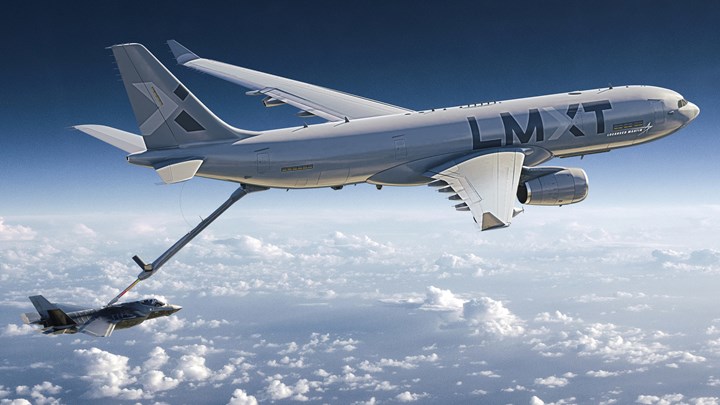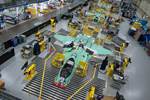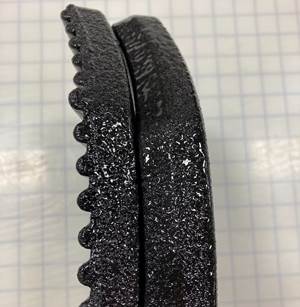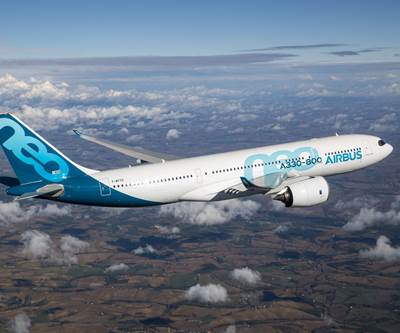Lockheed Martin's LMXT strategic tanker aircraft will be made in Alabama and Georgia
The LMXT is produced as a composites-intensive A330 airliner at Airbus’ Mobile, Alabama, facility and converted into tanker role at Lockheed’s facility in Marietta, Georgia.

LMXT strategic tank. Photo Credit: Lockheed Martin
Lockheed Martin (Bethesda, Md., U.S.) leaders announced on Jan. 31 the LMXT strategic tanker aircraft — produced as an A330 airliner — will be manufactured in Mobile, Ala., and Marietta, Ga. Introduced in Sept 2021, the LMXT is Lockheed Martin’s offering for the U.S. Air Force’s (USAF’s) KC-Y “Bridge Tanker” Program competition.
“Establishing this production work in Alabama and Georgia confirms Lockheed Martin’s commitment that the LMXT will be built in America, by Americans, for Americans,” says James Taiclet, Lockheed Martin chairman, president and CEO. “The LMXT will strengthen global security by enabling our U.S. service members to carry out their most critical missions at extended ranges. At home, the LMXT will strengthen job growth and manufacturing by drawing on the experience and talents of a high-tech U.S. workforce in two states that are proven leaders in aviation.”
With Lockheed Martin as the prime contractor, the LMXT will be built in two phases: First, the LMXT is produced as an A330 airliner at Airbus’ Mobile, Ala., facility, which is where Airbus A320 and A220 commercial airliners are built. The second phase of the manufacturing process includes converting the commercial aircraft into the LMXT tanker at Lockheed Martin Aeronautics’ Marietta, Ga., facility, which is currently home to the C-130J Super Hercules final production and F-35 Lightning II center wing assembly lines.
Lockheed Martin and Airbus entered into a Memorandum of Agreement (MOA) in 2018 to explore aerial-refueling solutions to address any refueling capacity shortfalls for the USAF, with the Airbus A330 Multi Role Tanker Transport (MRTT) at the center of its discussions. The LMXT is a result of this MOA, offering a proven airframe with distinct USAF-only capabilities built by a highly skilled U.S. workforce in two states with experience in aerospace manufacturing.
The LMXT represents the newest chapter in Lockheed Martin’s 60-plus year history of producing and delivering tanker and large aircraft for the USAF, U.S. Marine Corps, U.S. Navy and multiple operators around the world.
“Over our 50-year history in the U.S., some of our proudest moments have come from supporting our U.S. service members,” says C. Jeffrey Knittel, chairman and ceo of Airbus Americas. “Our U.S. workforce, which is more than 35% military veterans, is eager to see an Air Force tanker join the fleet of Airbus aircraft flying for the U.S. Army, National Guard, Navy and Coast Guard.”
The expansion of work by both Lockheed Martin and Airbus in Alabama and Georgia is a natural progression for the companies, each having deep roots in both states. Lockheed Martin’s presence in northern Alabama spans more than five decades, with a concentration in the rotorcraft and hypersonics sectors. More than 2,600 Lockheed Martin employees live and work in Alabama. In October 2021, Lockheed Martin opened an advanced production facility in Courtland focused on hypersonic strike production.
Further, than 5,000 Lockheed Martin employees support work at its Aeronautics facility in Marietta as well as in other facilities in Macon and Kings Bay. The Marietta facility has produced military aircraft since 1951 to include every production C-130 Hercules (2,600-plus), the C-5 Galaxy/Super Galaxy, the P-3 Orion, the F-22 Raptor and the C-141 Starlifter. More than 4,500 employees currently work at the site.
More than 630 suppliers across both states support Lockheed Martin programs. In 2020, Lockheed Martin Aeronautics contributed more than $2.6 million in both states supporting military, education and community-based organizations.
Airbus has been assembling commercial aircraft in Mobile since 2015, and in the first five years of operation reportedly had a total economic impact in Alabama of $1.2 billion and more than 15,000 jobs, through construction and payroll alone. Airbus is also engaged with more than 40 local charitable and civic organizations in the region, investing both time and money in the local community.
The LMXT offers the following:
- Improved range and fuel offload capacity over current tankers;
- A fly-by-wire boom currently certified and used by allies to refuel USAF receiver aircraft in operations around the world;
- Said to be the world’s first fully automatic boom/air-to-air refueling (A3R) system;
- Operational- and combat-proven advanced camera and rear vision system;
- Open system architecture JADC2 systems;
- Established allied interoperability and resilient global supply chain;
- Multi-domain operations node that connects the LMXT to the larger battlespace, increasing onboard situational awareness to provide resilient communications and datalink for assets across the force;
- Permanently installed aeromedevac suite enabling medical care with intercontinental reach;
- Forklift-accessible cargo capacity for six military pallets with weights of up to 70 kilograms/pound. for austere base support.
As the prime contractor, Lockheed Martin works directly to implement USAF-specific requirements within the LMXT.
Related Content
Plant tour: Renegade Materials Corp., Miamisburg, Ohio, U.S.
Renegade Materials is known for high-performance prepregs for aerospace applications. Following its acquisition by Teijin in 2019, the company has expanded capacity and R&D efforts on a range of aerospace-targeted materials.
Read MoreLifePort acquires Aeromatrix Composites advanced materials line
The aircraft manufacturer solidifies its capability to provide next-generation advanced materials solutions to aerospace and defense customers.
Read MoreUS Air Force selects Integris Composites ballistic body armor
Cratus Wave armor is thin, lightweight and reduces heat stress, providing buoyant personal protection for the 582nd Helicopter Group.
Read MoreFrom the CW Archives: Airbus A400M cargo door
The inaugural CW From the Archives revisits Sara Black’s 2007 story on out-of-autoclave infusion used to fabricate the massive composite upper cargo door for the Airbus A400M military airlifter.
Read MoreRead Next
Lockheed Martin Aeronautics adopts Siemens’ Xcelerator portfolio
Software and services to support the digital engineering transformation of the F-35, including the program’s use of composite materials and processes.
Read MoreAirbus A330-800 receives joint EASA and FAA Type Certification
The widebody aircraft, part of the A330neo family, incorporates composite materials, a 3D-optimized wing and other advances for 25% reduced fuel consumption.
Read MoreVIDEO: High-volume processing for fiberglass components
Cannon Ergos, a company specializing in high-ton presses and equipment for composites fabrication and plastics processing, displayed automotive and industrial components at CAMX 2024.
Read More














.jpg;maxWidth=300;quality=90)











